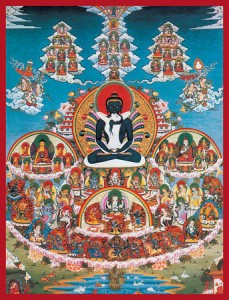The following is an excerpt from a teaching by Jetsunma Ahkon Lhamo called “Faults of Cyclic Existence”
What I would like to talk about today has much to do with the practice of Bodhicitta, which is taking the vow of compassion, committing oneself to live one’s life as a compassionate person, and moving into adopting the posture of and becoming a Bodhisattva., that is an awakening being who lives to benefit others.
Generally speaking, Refuge and Bodhicitta are considered to be almost like twins. Many times practitioners will structure their practice so that they are accumulating Rand Bodhicitta at the same time. You’ll notice that the two sections in your Ngöndro book are side by side and that one easily follows the other. To help you with understanding how to live through the muscular changes that you are going through even as we speak, one thing that you can do that I did that is very helpful is that when you’re practicing the Refuge and you’ve established the visualization, you’re halfway there to the Bodhicitta because it moves directly into the practice of Bodhicitta, using pretty much the same visualization.
If you are accumulating prostrations, either you are in retreat or you are simply upholding your daily practice commitment. There will be times when you really feel that in a physical way you simply cannot put up with the challenge of the practice. Each one of you will have a certain limit of prostrations that you can consistently do on a regular basis. If you were to do a daily practice commitment of 100 prostrations, or 200 prostrations, or 300 prostrations, whatever it is, there will be some days that for whatever physiological reason you may not be able to do that much, or it may be that you are moving from 100 prostrations to 200 prostrations and the body is stressed as it’s going to this new level. The one thing that you can do is combine the practice of Refuge and Bodhicitta. You can practice the Refuge, accumulating prostrations until you feel that you are tired and need to move on to something else or take a break. Then you can sit down and visualize and meditate on the bodhicitta section of the practice. So you could take a break, accumulate Bodhicitta Vow for awhile and use that visualization, and if that’s the only time you’re going to accumulate bodhicitta, you can close the practice at that point. But you can close the practice of Bodhicitta somewhat and then go back to the Refuge practice, or you can actually go back and forth.
Interestingly they are so connected in one’s mind, and should be so connected in one’s mind, that that’s actually an excellent way to practice and I recommend, rather than doing only prostrations, to go back and forth on a regular basis and accumulate the bodhicitta at the same time. Now the reason why this is very useful is that the idea of refuge and bodhicitta in concept are so well-connected and so interdependent, literally, it’s hard to understand one without the other.
Yesterday during the retreat we talked about the meaning of refuge. We talked about the thoughts that turn the mind. We talked about the pitfalls and conditions of samsaric or cyclic existence, the cycle of birth and death, so we talked about many different subjects. How do these subjects connect with bodhicitta and how does bodhicitta connect with these subjects?
Actually the two main legs of our entire path are wisdom and compassion—the knowledge of emptiness or the realization of the primordial wisdom state and the bodhicitta. These two are as inseparable as the rays of the sun are from the sun. If one were to examine the sun, one would understand that yes, there seems to be a place where the sun’s actual body ends, but is the energy of the sun’s rays, is that emanation form of the sun, actually in truth separate from the sun itself? Some would say no. So in many ways refuge and bodhicitta have the same kind of relationship.
Copyright © Jetsunma Ahkon Norbu Lhamo All rights reserved












Refuge and Bodhichita are complimentary S